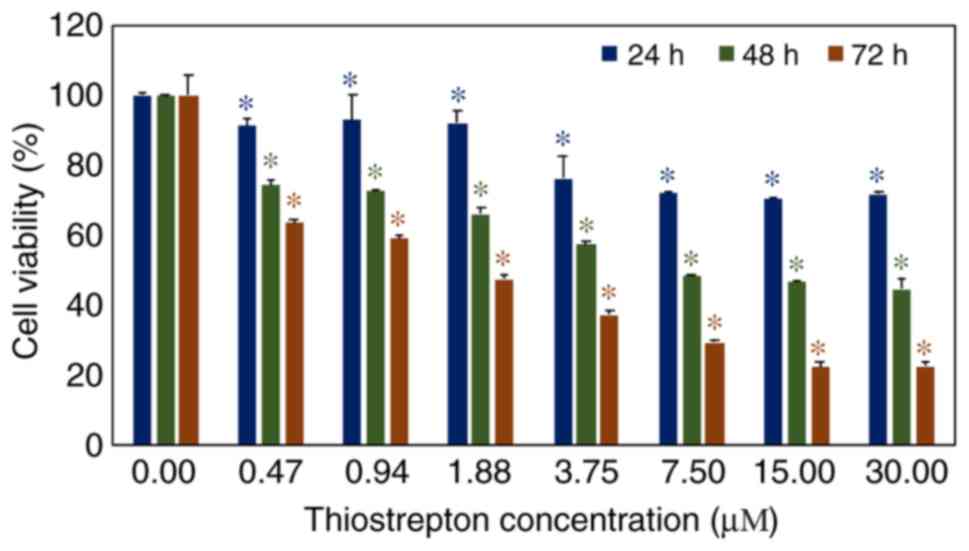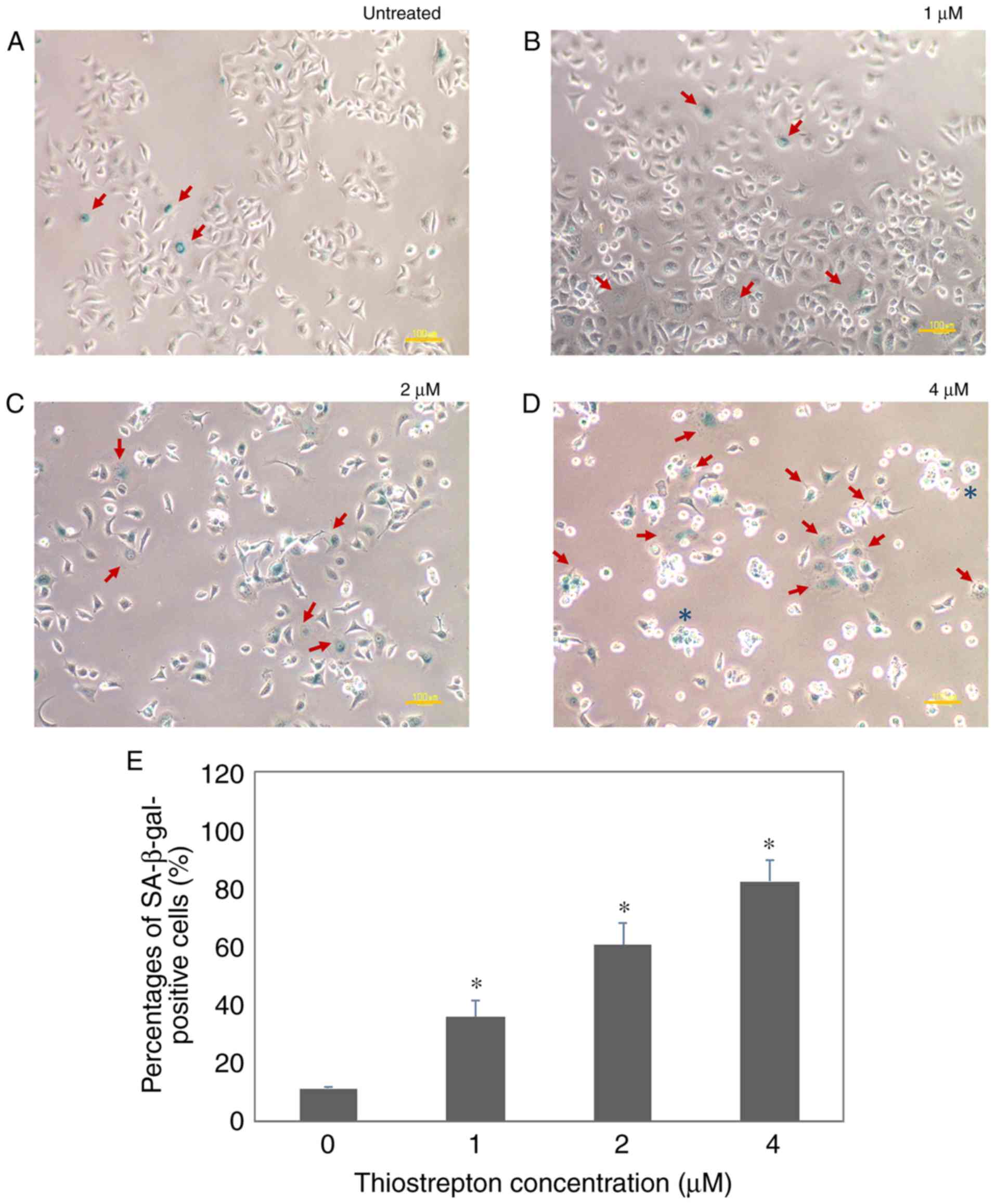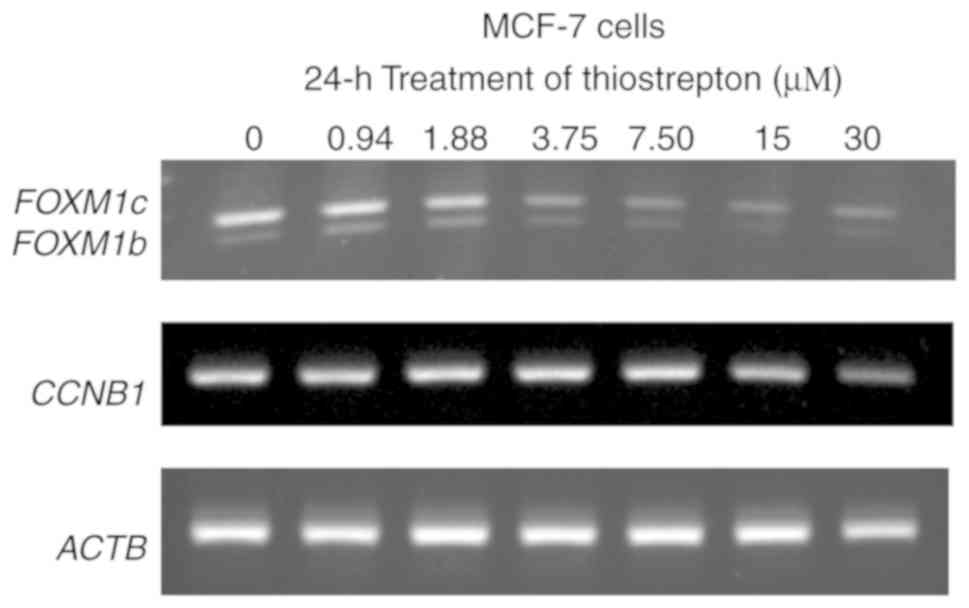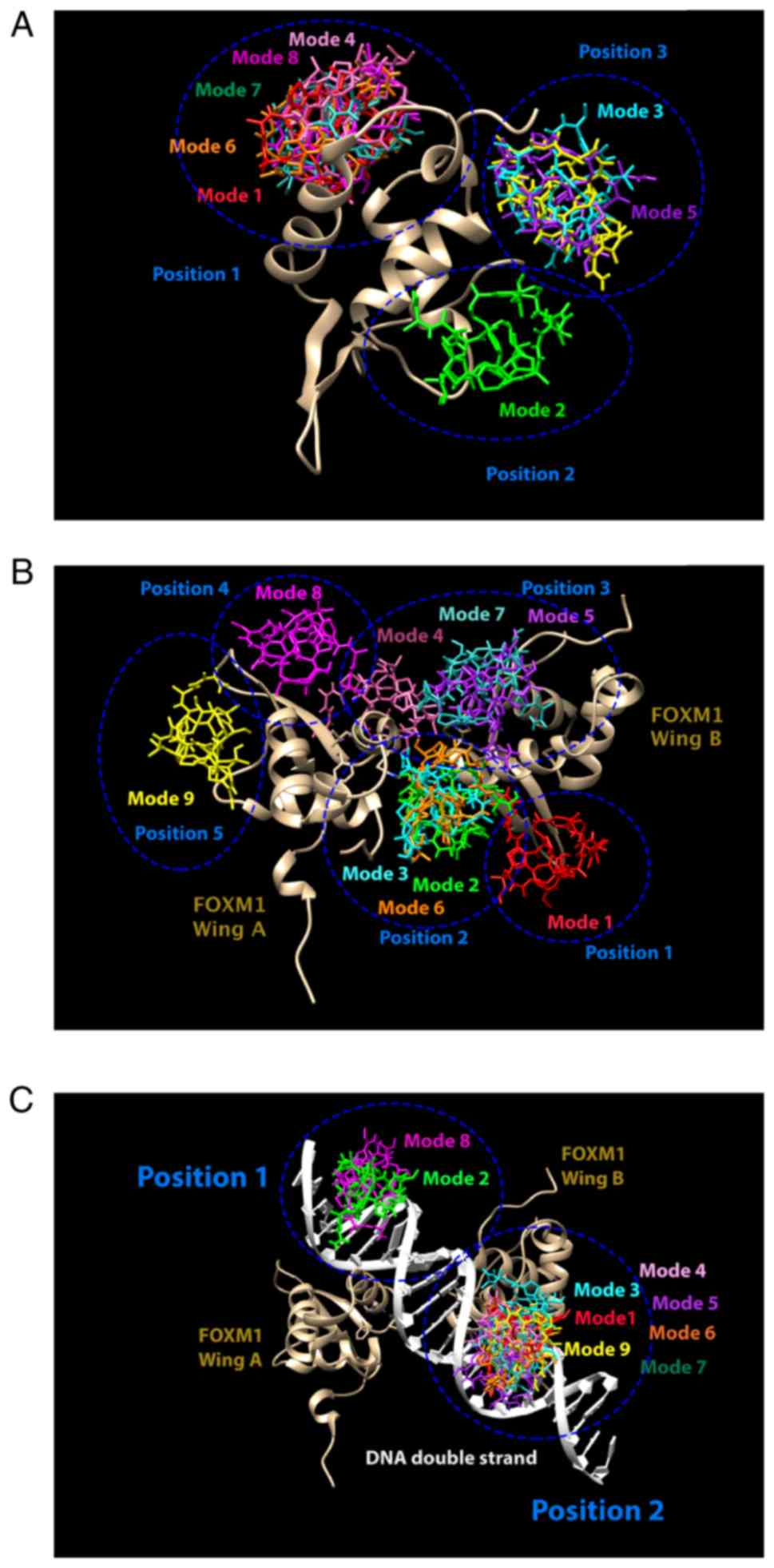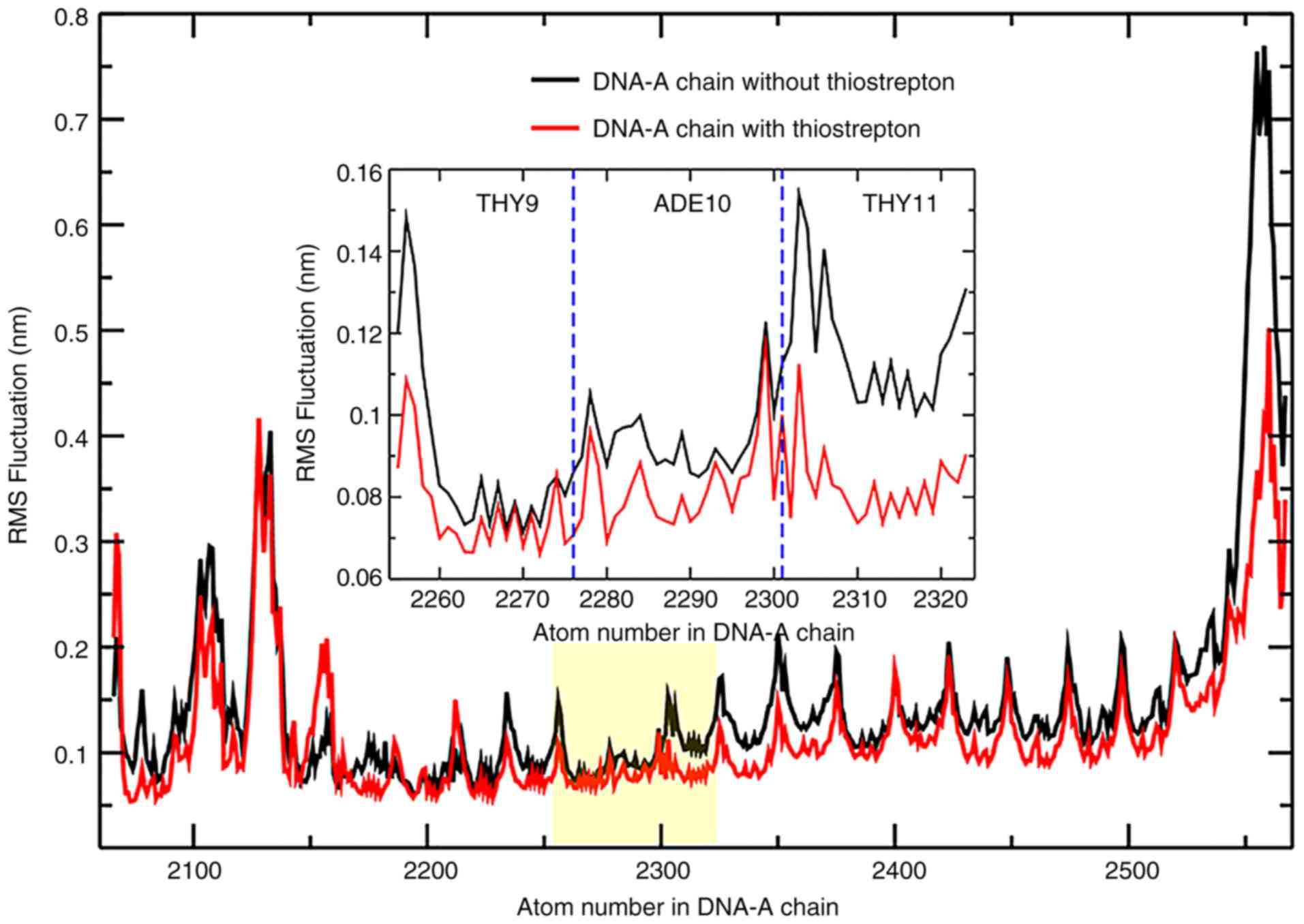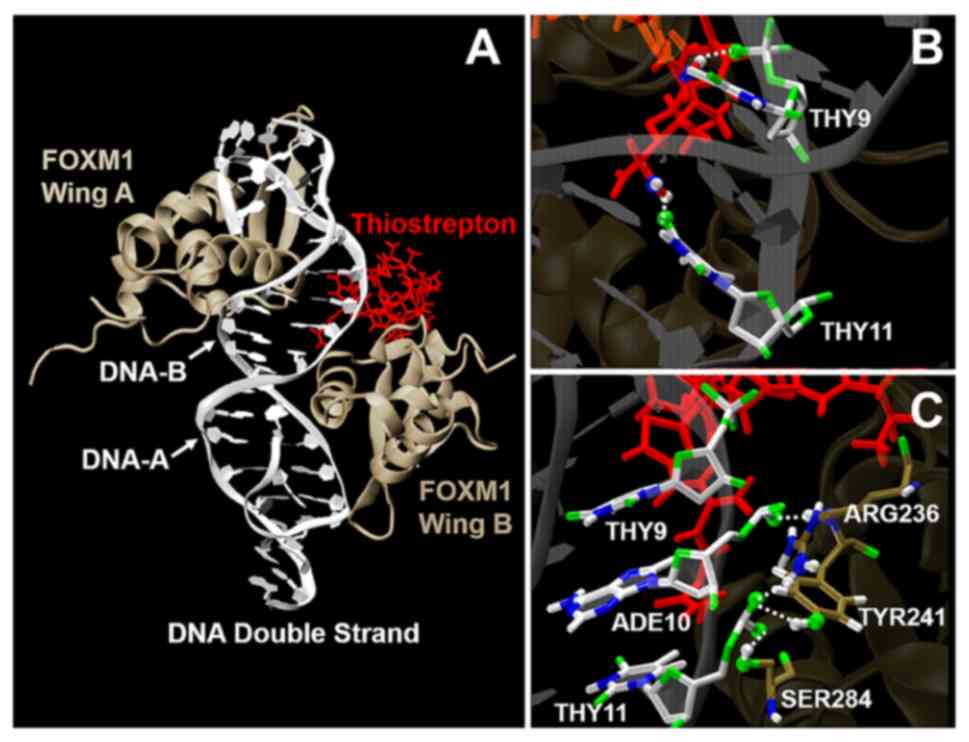|
1
|
Krebs MG, Hou JM, Ward TH, Blackhall FH
and Dive C: Circulating tumour cells: Their utility in cancer
management and predicting outcomes. Ther Adv Med Oncol. 2:351–365.
2010. View Article : Google Scholar : PubMed/NCBI
|
|
2
|
Thorn CF, Oshiro C, Marsh S,
Hernandez-Boussard T, McLeod H, Klein TE and Altman RB: Doxorubicin
pathways: Pharmacodynamics and adverse effects. Pharmacogenet
Genomics. 21:440–446. 2011. View Article : Google Scholar : PubMed/NCBI
|
|
3
|
Myatt SS, Kongsema M, Man CW, Kelly DJ,
Gomes AR, Khongkow P, Karunarathna U, Zona S, Langer JK, Dunsby CW,
et al: SUMOylation inhibits FOXM1 activity and delays mitotic
transition. Oncogene. 33:4316–4329. 2014. View Article : Google Scholar : PubMed/NCBI
|
|
4
|
Khongkow P, Karunarathna U, Khongkow M,
Gong C, Gomes AR, Yagüe E, Monteiro LJ, Kongsema M, Zona S, Man EP,
Tsang JW, et al: FOXM1 targets NBS1 to regulate DNA damage-induced
senescence and epirubicin resistance. Oncogene. 33:4144–4155. 2014.
View Article : Google Scholar : PubMed/NCBI
|
|
5
|
Monteiro LJ, Khongkow P, Kongsema M,
Morris JR, Man C, Weekes D, Koo CY, Gomes AR, Pinto PH, Varghese V,
et al: The Forkhead Box M1 protein regulates BRIP1 expression and
DNA damage repair in epirubicin treatment. Oncogene. 32:4634–4645.
2013. View Article : Google Scholar : PubMed/NCBI
|
|
6
|
Koo CY, Muir KW and Lam EW: FOXM1: From
cancer initiation to progression and treatment. Biochim Biophys
Acta. 1819:28–37. 2012. View Article : Google Scholar : PubMed/NCBI
|
|
7
|
Millour J, de Olano N, Horimoto Y,
Monteiro LJ, Langer JK, Aligue R, Hajji N and Lam EW: ATM and p53
regulate FOXM1 expression via E2F in breast cancer epirubicin
treatment and resistance. Mol Cancer Ther. 10:1046–1058. 2011.
View Article : Google Scholar : PubMed/NCBI
|
|
8
|
Karunarathna U, Kongsema M, Zona S, Gong
C, Cabrera E, Gomes AR, Man EP, Khongkow P, Tsang JW, Khoo US, et
al: OTUB1 inhibits the ubiquitination and degradation of FOXM1 in
breast cancer and epirubicin resistance. Oncogene. 35:1433–1444.
2016. View Article : Google Scholar : PubMed/NCBI
|
|
9
|
Laoukili J, Stahl M and Medema RH: FoxM1:
At the crossroads of ageing and cancer. Biochim Biophys Acta.
1775:92–102. 2007.PubMed/NCBI
|
|
10
|
Nicolaou KC, Zak M, Rahimipour S, Estrada
AA, Lee SH, O'Brate A, Giannakakou P and Ghadiri MR: Discovery of a
biologically active thiostrepton fragment. J Am Chem Soc.
127:15042–15044. 2005. View Article : Google Scholar : PubMed/NCBI
|
|
11
|
Kwok JM, Myatt SS, Marson CM, Coombes RC,
Constantinidou D and Lam EW: Thiostrepton selectively targets
breast cancer cells through inhibition of forkhead box M1
expression. Mol Cancer Ther. 7:2022–2032. 2008. View Article : Google Scholar : PubMed/NCBI
|
|
12
|
Ahmed M, Hussain A, Begum R, Thangavel S,
Ajarim DS, Beg S, Uddin S and Al-Kuraya KS: Abstract 55:
Over-expression of FoxM1 in breast cancer can be therapeutically
targeted using thiostrepton. Cancer Res. 75:55. 2015.
|
|
13
|
Collado M and Serrano M: Senescence in
tumours: Evidence from mice and humans. Nat Rev Cancer. 10:51–57.
2010. View Article : Google Scholar : PubMed/NCBI
|
|
14
|
Rodier F and Campisi J: Four faces of
cellular senescence. J Cell Biol. 192:547–556. 2011. View Article : Google Scholar : PubMed/NCBI
|
|
15
|
Gartel AL: Thiostrepton, proteasome
inhibitors and FOXM1. Cell Cycle. 10:4341–4342. 2011. View Article : Google Scholar : PubMed/NCBI
|
|
16
|
Hegde NS, Sanders DA, Rodriguez R and
Balasubramanian S: The transcription factor FOXM1 is a cellular
target of the natural product thiostrepton. Nat Chem. 3:725–731.
2011. View Article : Google Scholar : PubMed/NCBI
|
|
17
|
Gartel AL: Suppression of the oncogenic
transcription factor FOXM1 by proteasome inhibitors. Scientifica
(Cairo). 2014:5965282014.PubMed/NCBI
|
|
18
|
Gartel AL: Targeting FOXM1 auto-regulation
in cancer. Cancer Biol Ther. 16:185–186. 2015. View Article : Google Scholar : PubMed/NCBI
|
|
19
|
Bhat UG, Halasi M and Gartel AL: Thiazole
antibiotics target FoxM1 and induce apoptosis in human cancer
cells. PLoS One. 4:e55922009. View Article : Google Scholar : PubMed/NCBI
|
|
20
|
Gartel AL: A new target for proteasome
inhibitors: FoxM1. Expert Opin Investig Drugs. 19:235–242. 2010.
View Article : Google Scholar : PubMed/NCBI
|
|
21
|
Chen Y, Ruben EA, Rajadas J and Teng NN:
In silico investigation of FOXM1 binding and novel inhibitors in
epithelial ovarian cancer. Bioorg Med Chem. 23:4576–4582. 2015.
View Article : Google Scholar : PubMed/NCBI
|
|
22
|
Gartel AL: Thiazole antibiotics siomycin a
and thiostrepton inhibit the transcriptional activity of FOXM1.
Front Oncol. 3:1502013. View Article : Google Scholar : PubMed/NCBI
|
|
23
|
Nakamura S, Hirano I, Okinaka K, Takemura
T, Yokota D, Ono T, Shigeno K, Shibata K, Fujisawa S and Ohnishi K:
The FOXM1 transcriptional factor promotes the proliferation of
leukemia cells through modulation of cell cycle progression in
acute myeloid leukemia. Carcinogenesis. 31:2012–2021. 2010.
View Article : Google Scholar : PubMed/NCBI
|
|
24
|
Villa-Diaz LG, Garcia-Perez JL and
Krebsbach PH: Enhanced transfection efficiency of human embryonic
stem cells by the incorporation of DNA liposomes in extracellular
matrix. Stem Cells Dev. 19:1949–1957. 2010. View Article : Google Scholar : PubMed/NCBI
|
|
25
|
Littler DR, Alvarez-Fernández M, Stein A,
Hibbert RG, Heidebrecht T, Aloy P, Medema RH and Perrakis A:
Structure of the FoxM1 DNA-recognition domain bound to a promoter
sequence. Nucleic Acids Res. 38:4527–4538. 2010. View Article : Google Scholar : PubMed/NCBI
|
|
26
|
Jonker HR, Baumann S, Wolf A, Schoof S,
Hiller F, Schulte KW, Kirschner KN, Schwalbe H and Arndt HD: NMR
structures of thiostrepton derivatives for characterization of the
ribosomal binding site. Angew Chem Int Ed Engl. 50:3308–3312. 2011.
View Article : Google Scholar : PubMed/NCBI
|
|
27
|
Malde AK, Zuo L, Breeze M, Stroet M, Poger
D, Nair PC, Oostenbrink C and Mark AE: An automated force field
topology builder (ATB) and repository: Version 1.0. J Chem Theory
Comput. 7:4026–4037. 2011. View Article : Google Scholar : PubMed/NCBI
|
|
28
|
Canzar S, El-Kebir M, Pool R, Elbassioni
K, Mark AE, Geerke DP, Stougie L and Klau GW: Charge Group
Partitioning in Biomolecular Simulation. J Comput Biol. 20:188–198.
2013. View Article : Google Scholar : PubMed/NCBI
|
|
29
|
Koziara KB, Stroet M, Malde AK and Mark
AE: Testing and validation of the Automated Topology Builder (ATB)
version 2.0: Prediction of hydration free enthalpies. J Comput Aid
Mol Des. 28:221–233. 2014. View Article : Google Scholar
|
|
30
|
Trott O and Olson AJ: Software news and
update AutoDock Vina: Improving the speed and accuracy of docking
with a new scoring function, efficient optimization, and
multithreading. J Comput Chem. 31:455–461. 2010.PubMed/NCBI
|
|
31
|
Abraham MJ, Murtola T, Schulz R, Páll S,
Smith JC, Hess B and Lindahl E: GROMACS: High performance molecular
simulations through multi-level parallelism from laptops to
supercomputers. SoftwareX 1–2. 19–25. 2015. View Article : Google Scholar
|
|
32
|
Oostenbrink C, Villa A, Mark AE and Van
Gunsteren WF: A biomolecular force field based on the free enthalpy
of hydration and solvation: The GROMOS force-field parameter sets
53A5 and 53A6. J Comput Chem. 25:1656–1676. 2004. View Article : Google Scholar : PubMed/NCBI
|
|
33
|
Berendsen HJC, Postma JPM, Gunsteren WF
and Hermans J: Interaction models for water in relation to protein
hydration. Intermolecular forces. Pullman B: 14. Springer; Berlin:
pp. 331–334. 1981, View Article : Google Scholar
|
|
34
|
Bussi G, Donadio D and Parrinello M:
Canonical sampling through velocity rescaling. J Chem Phys.
126:2007. View Article : Google Scholar : PubMed/NCBI
|
|
35
|
Bussi G, Zykova-Timan T and Parrinello M:
Isothermal-isobaric molecular dynamics using stochastic velocity
rescaling. J Chem Phys. 130:0741012009. View Article : Google Scholar : PubMed/NCBI
|
|
36
|
Parrinello M and Rahman A: Polymorphic
transitions in single crystals: A new molecular dynamics method. J
Appl Phys. 52:1981. View Article : Google Scholar
|
|
37
|
Darden T, York D and Pedersen L: Particle
mesh Ewald: An N I log(N) method for Ewald sums in large systems. J
Chem Phys. 98:100891993. View Article : Google Scholar
|
|
38
|
Essmann U, Perera L and Berkowitz ML: A
smooth particle mesh Ewald method. J Chem Phys. 103:85771995.
View Article : Google Scholar
|
|
39
|
Wong-Ekkabut J and Karttunen M: Assessment
of common simulation protocols for simulations of nanopores,
membrane proteins, and channels. J Chem Theory Comput. 8:2905–2911.
2012. View Article : Google Scholar : PubMed/NCBI
|
|
40
|
Hess B: P-LINCS: A parallel linear
constraint solver for molecular simulation. J Chem Theory Comput.
4:116–122. 2008. View Article : Google Scholar : PubMed/NCBI
|
|
41
|
Humphrey W, Dalke A and Schulten K: VMD:
Visual molecular dynamics. J Mol Graph. 14:33–38, 27-38. 1996.
View Article : Google Scholar : PubMed/NCBI
|
|
42
|
Halasi M and Gartel AL: A novel mode of
FoxM1 regulation: Positive auto-regulatory loop. Cell Cycle.
8:1966–1967. 2009. View Article : Google Scholar : PubMed/NCBI
|
|
43
|
Leung TW, Lin SS, Tsang AC, Tong CS, Ching
JC, Leung WY, Gimlich R, Wong GG and Yao KM: Over-expression of
FoxM1 stimulates cyclin B1 expression. FEBS Lett. 507:59–66. 2001.
View Article : Google Scholar : PubMed/NCBI
|
|
44
|
Liao GB, Li XZ, Zeng S, Liu C, Yang SM,
Yang L, Hu CJ and Bai JY: Regulation of the master regulator FOXM1
in cancer. Cell Commun Signal. 16:572018. View Article : Google Scholar : PubMed/NCBI
|
|
45
|
Kong X, Li L, Li Z, Le X, Huang C, Jia Z,
Cui J, Huang S, Wang L and Xie K: Dysregulated expression of FOXM1
isoforms drives progression of pancreatic cancer. Cancer Res.
73:3987–3996. 2013. View Article : Google Scholar : PubMed/NCBI
|
|
46
|
Cheng XH, Black M, Ustiyan V, Le T,
Fulford L, Sridharan A, Medvedovic M, Kalinichenko VV, Whitsett JA
and Kalin TV: SPDEF inhibits prostate carcinogenesis by disrupting
a positive feedback loop in regulation of the Foxm1 oncogene. PLoS
Genet. 10:e10046562014. View Article : Google Scholar : PubMed/NCBI
|
|
47
|
Korver W, Roose J and Clevers H: The
winged-helix transcription factor Trident is expressed in cycling
cells. Nucleic Acids Res. 25:1715–1719. 1997. View Article : Google Scholar : PubMed/NCBI
|
|
48
|
Sanders DA, Gormally MV, Marsico G,
Beraldi D, Tannahill D and Balasubramanian S: FOXM1 binds directly
to non-consensus sequences in the human genome. Genome Biol.
16:1302015. View Article : Google Scholar : PubMed/NCBI
|
|
49
|
Tabatabaei-Dakhili SA, Aguayo-Ortiz R,
Domínguez L and Velázquez-Martínez CA: Untying the knot of
transcription factor druggability: Molecular modeling study of
FOXM1 inhibitors. J Mol Graph Model. 80:197–210. 2018. View Article : Google Scholar : PubMed/NCBI
|
|
50
|
Van Der Spoel D, Lindahl E, Hess B,
Groenhof G, Mark AE and Berendsen HJ: GROMACS: Fast, flexible, and
free. J Comput Chem. 26:1701–1718. 2005. View Article : Google Scholar : PubMed/NCBI
|
|
51
|
Tassi RA, Todeschini P, Siegel ER, Calza
S, Cappella P, Ardighieri L, Cadei M, Bugatti M, Romani C, Bandiera
E, et al: FOXM1 expression is significantly associated with
chemotherapy resistance and adverse prognosis in non-serous
epithelial ovarian cancer patients. J Exp Clin Cancer Res.
36:632017. View Article : Google Scholar : PubMed/NCBI
|
|
52
|
Ye H, Kelly TF, Samadani U, Lim L, Rubio
S, Overdier DG, Roebuck KA and Costa RH: Hepatocyte nuclear factor
3/fork head homolog 11 is expressed in proliferating epithelial and
mesenchymal cells of embryonic and adult tissues. Mol Cell Biol.
17:1626–1641. 1997. View Article : Google Scholar : PubMed/NCBI
|
|
53
|
Yao KM, Sha M, Lu Z and Wong GG: Molecular
analysis of a novel winged helix protein, WIN. Expression pattern,
DNA binding property, and alternative splicing within the DNA
binding domain. J Biol Chem. 272:19827–19836. 1997. View Article : Google Scholar : PubMed/NCBI
|
|
54
|
Gormally M, Marsico G, Rai G, Lowe C,
Thomas C, Maloney D, Michael S, Matak-Vincovic D, Jadhav A,
Simeonov A and Balasubramanian S: Abstract 3088: Transcription
factor as target: Novel small molecule inhibits FOXM1 DNA binding
and oncogenic gene products. Cancer Res. 76:3088. 2016.PubMed/NCBI
|
|
55
|
Gormally MV, Dexheimer TS, Marsico G,
Sanders DA, Lowe C, Matak-Vinković D, Michael S, Jadhav A, Rai G,
Maloney DJ, et al: Suppression of the FOXM1 transcriptional
programme via novel small molecule inhibition. Nat Commun.
5:51652014. View Article : Google Scholar : PubMed/NCBI
|
|
56
|
Marsico G and Gormally MV: Small molecule
inhibition of FOXM1: How to bring a novel compound into genomic
context. Genom Data. 3:19–23. 2015. View Article : Google Scholar : PubMed/NCBI
|
|
57
|
Marklund EG, Mahmutovic A, Berg OG, Hammar
P, van der Spoel D, Fange D and Elf J: Transcription-factor binding
and sliding on DNA studied using micro- and macroscopic models.
Proc Natl Acad Sci USA. 110:19796–19801. 2013. View Article : Google Scholar : PubMed/NCBI
|
|
58
|
Zhang X, Cheng L, Minn K, Madan R, Godwin
AK, Shridhar V and Chien J: Targeting of mutant p53-induced FoxM1
with thiostrepton induces cytotoxicity and enhances carboplatin
sensitivity in cancer cells. Oncotarget. 5:11365–11380.
2014.PubMed/NCBI
|















